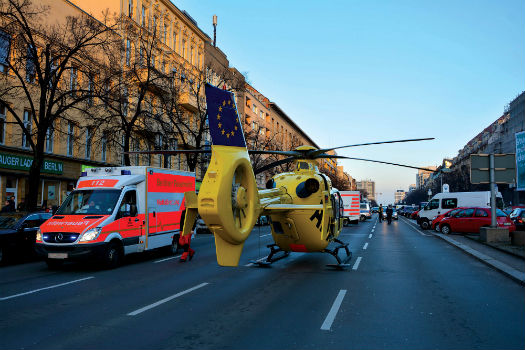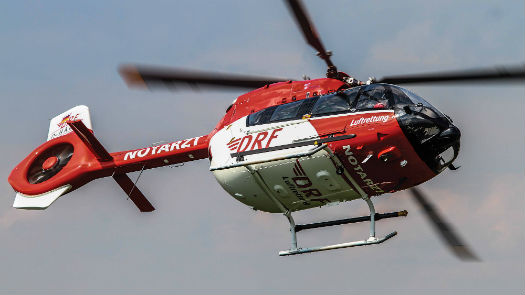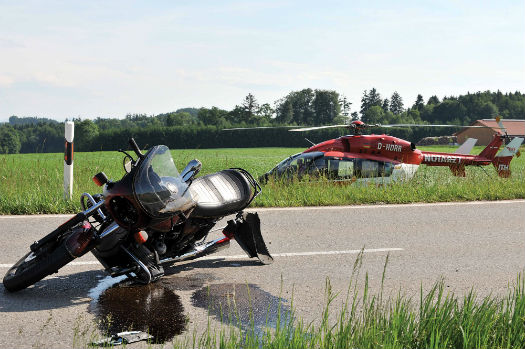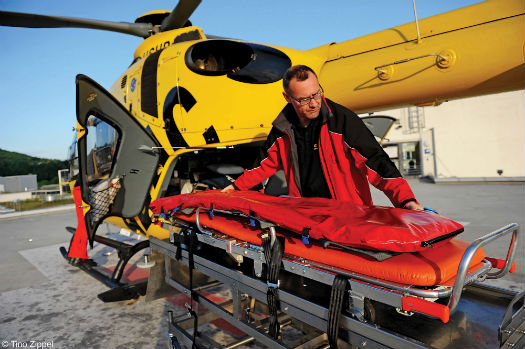
The German helicopter emergency medical services (HEMS) industry is almost 45 years old. Its two largest operators — ADAC Luftrettung (pictured) and DRF Luftrettung — are both non-profit organizations. Steven Bartsch Photo
German helicopter emergency medical services (HEMS) have been on the cutting edge of the industry ever since the first civilian service was established in the country almost 45 years ago. A dense network, revenue streams from both donors and health insurers, and a close cooperation with Airbus Helicopters have combined to create a very effective scheme for victim rescue and patient transfer. Although its players are the first to admit it’s not perfect, such is the strength of the German HEMS system that the design of some popular light twins — the workhorses of numerous HEMS providers around the world — have been sculpted by operations in the country.
The largest operators in Germany are ADAC Luftrettung (owned by ADAC, the country’s automobile club) and DRF Luftrettung — and they’re both non-profit corporations. BBK, the German federal government’s civil protection and disaster response organization, also has a significant presence in HEMS operations in the country (its fleet is flown and maintained by the federal police’s aviation group).
“HEMS activity breaks down into approximately 50 percent operated by ADAC, 30 to 40 percent for DRF and most of the rest for BBK,” Frédéric Bruder, ADAC Luftrettung CEO, told Vertical 911. There are also a few small operators — such as Die Johanniter — who provide HEMS in the country.

Night vision goggle use in German HEMS aircraft is growing with the new platforms now joining operator fleets. Round-the-clock operation currently takes place at eight DRF Luftrettung and four ADAC Luftrettung bases. DRF luftrettung Photo
In terms of operational authority, Bruder said ADAC has total control over both the aviation and medical services it delivers. While the doctor onboard may be seconded by a hospital, or be a freelancer, he or she is required to act as if they were the helicopter company’s employee, utilizing ADAC’s standard operating procedures. The paramedics, who assist both the pilot and the doctor, are under the operator’s authority, too.
The Non-Profit Picture
One of the major advantages of being a non-profit organization for DRF and ADAC is that members and donors can cover a financial loss. This takes a lot of pressure off company executives and, at the operational level, pilots.
Nevertheless, Bruder pointed out that the German remuneration system is not ideal. Every state in Germany issues tenders for air rescue and awards contracts on a fixed flight-hour rate basis, for a period of five to 15 years. “But then, the winner has to renegotiate this rate with the health insurance organization, which actually will pay for the service,” Bruder explained. Once it has won the contract, the operator must provide the service, regardless of the final rate, even though it may ultimately be lower than the rate agreed at the tender stage.

DRF Luftrettung received the world’s first Airbus Helicopters EC145 T2 in July 2014. The operator’s version of the aircraft, which includes about $625,000 of medical equipment, has a unit price of $6.5 million. Airbus Helicopters/Charles Abarr Photo
And being paid a flight-hour rate (or, more precisely, a flight-minute rate) equates to “gathering 100 percent of our revenues during 15 percent of a base’s opening hours — when the helicopter is actually flying,” he said. The remaining 85 percent of the time, the helicopter is on the ground, either at the base or the accident site. “Yet, the community pays for us to be available from 7 a.m. until sundown every day, and even 24/7 on four bases, ready to take off at a two-minute notice,” said Bruder.
Almost 70 percent of ADAC Luftrettung’s costs are fixed, so only a small portion of its direct operating costs are incurred by the flight operations. According to Bruder, the best financing system would consist of a monthly base fee, which would cover the fixed costs (such as the helicopter and personnel), and a small flight-minute rate to cover the variable costs, such as maintenance and fuel. “Such a system would increase the level of safety by entirely taking away the pressure from operators to perform as many missions as possible to generate revenue,” he suggested.
According to Bruder, another existing “distortion” of the German HEMS system is the strict requirement to provide a medical service in order to collect a fee for a call. This results in an absence of payment if the patient has died by the time the HEMS crew reaches him or her. “I have gained HEMS experience in more than 10 countries and the German system is quite unique,” said Bruder.

With around 75 HEMS bases spread across Germany, there’s generally no more than a 15-minute flight time to any accident site from the nearest base. DRF luftrettung Photo
However, operators in other countries face even more challenging situations when it comes to remuneration. Thomas Hein, Airbus Helicopters’ VP for sales and customer relations in Europe, said that in Austria, when a helicopter brings a patient to a hospital, a doctor will judge whether the helicopter was necessary — if not, the operator doesn’t get paid. In Germany, this decision is made before a flight, with a dispatcher using a questionnaire to inform his or her decision on what mode of transport is most appropriate.
Extensive Coverage
A pillar of the German model is its very dense network — around 75 bases. With a 15-minute flight time to any accident site from the nearest base, this more than fulfills the “golden hour” concept, Hein noted. However, across Germany, clinics are increasingly specializing in treating specific types of injuries and illnesses, Stefanie Kapp, a spokesperson for DRF, noted. The average distance between the patients and clinics to which they’re being taken is thus becoming longer.
There is no official work sharing between the main HEMS players. Nevertheless, as DRF pilot Harald Weber said, “Whether an operator offers certain services, [such as a] rescue winch, depends generally on the location of the rescue base and the contract.” So if a base is located in the mountains, it’s more likely to have things like a hoist on its aircraft. While eight of DRF’s 28 bases operate around the clock, it leaves night search and rescue missions in the mountains to the police. “Our operator manual has presently no procedures for these missions and we don’t have a special training for pilots to fly under these conditions,” Weber explained.

ADAC has full authority over both the aviation and medical services it provides. Even if they’re not direct employees, the medics on board its aircraft are required to utilize the company’s standard operating procedures. ADAC luftrettung Photo
ADAC Luftrettung has 36 bases, and is gradually increasing the number of these that operate with night vision goggles (NVGs). Once the EC145 T2s it currently has on order have replaced its Airbus Helicopters BK-117s (which is scheduled to take place in 2018), all four of ADAC’s 24-hour bases will be equipped with NVG-compatible aircraft.
The introduction to market of the EC145 T2 will also result in changes at DRF. The company is currently in the process of phasing out its last remaining Bell 412s, along with early BK-117s. The manufacturer delivered the first EC145 T2 to DRF in July at its Donauwörth factory; ADAC received its first of the type two months later.

German operators have influenced the design of two of the most popular aircraft used for HEMS operations around the world — the EC135 and BK-117/EC145. DRF Luftrettung Photo
The EC145 T2s operated by DRF have a unit price of €6.5 million (US$8.1 million), which includes €500,000 ($625,000) of medical equipment, according to Kapp. Specialist interior manufacturer Bucher Leichtbau joined forces with ADAC and DRF in 2012 to begin working on the design of an EMS compartment for the aircraft. It includes seats, a stretcher, storage compartments and cabinets. All application profiles (such as intensive care transport or hoist rescue) are covered, Kapp said. The interior is also NVG-compatible.
The “center cabinet” in the middle of the cabin offers extended options, such as stowage space for the emergency rucksack, drawers, and fastening anchors for medical devices. In addition, different stretcher variants exist, which can be adapted to fit various patient profiles and applications.
This flexibility is the strength of the new concept, Kapp emphasized.

German HEMS operators are paid by flight-hour, but some believe a fixed monthly fee, with a small flight-minute fee to cover variable costs, would be a better solution. ADAC Luftrettung Photo
DRF was earlier involved, in an advisor role, in the development of the EC135. “This helicopter is tailored to the needs of air rescue,” said Kapp. “We accompanied its journey all the way to production and, in 1996, put the world’s first two helicopters of this kind into service. The same applies to the EC 145 T2.” The latter helicopter’s shrouded tail rotor and its inherent safety was praised by Steffen Lutz, executive board member of DRF Luftrettung.
“ADAC and DRF are pushing us to continuously adapt to the needs of EMS,” Airbus’ Hein said. “[The companies’ input] has driven the development of these models, especially for cabin size.”
Will the German model inspire other countries? In France, operators have long been complaining about contradicting requirements from civil aviation authorities and their national health system, while in the U.S., operators — and pilots in particular — are often under considerable economic pressure. Should these countries take a look at the German HEMS blueprint, they may well find something of great value.





